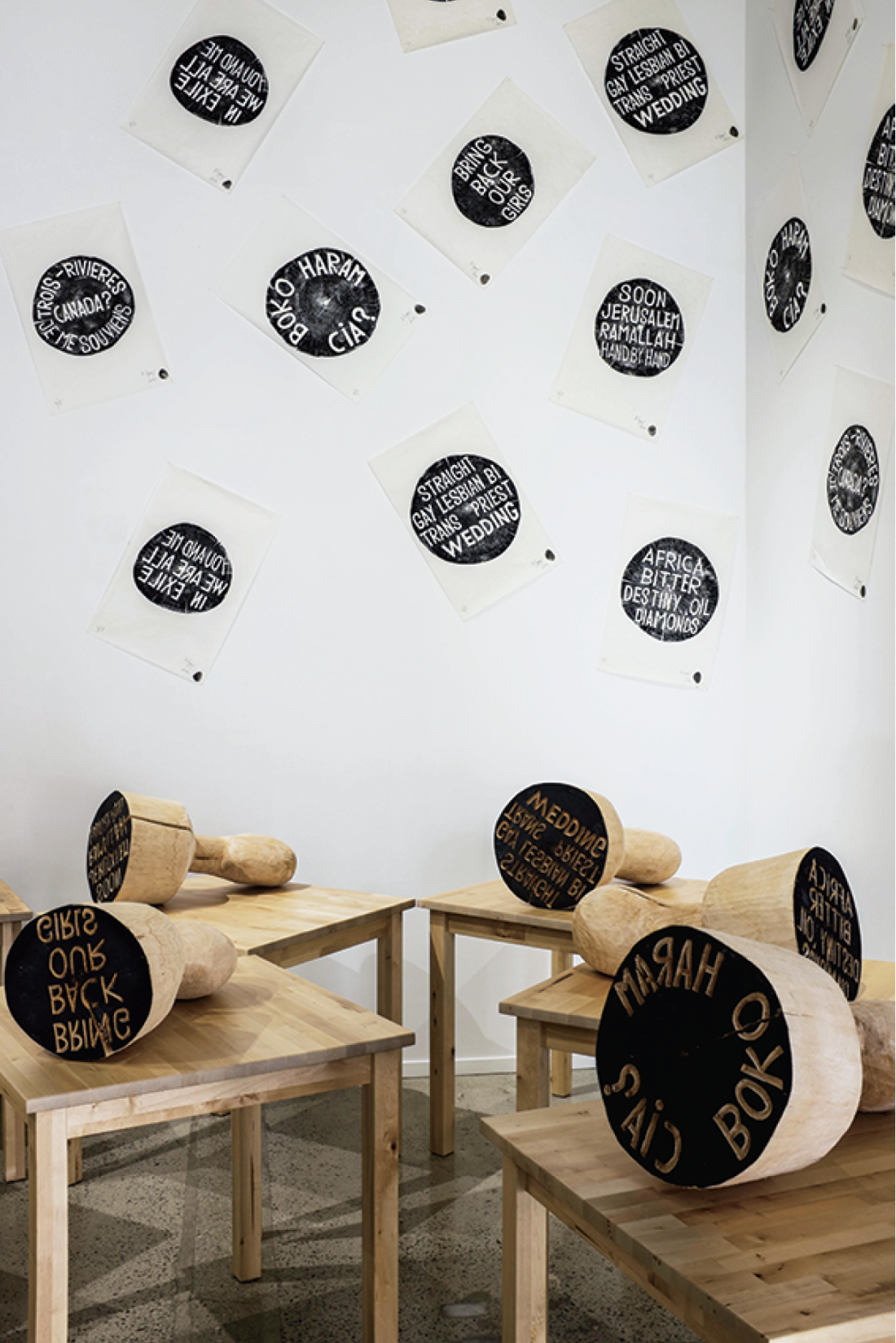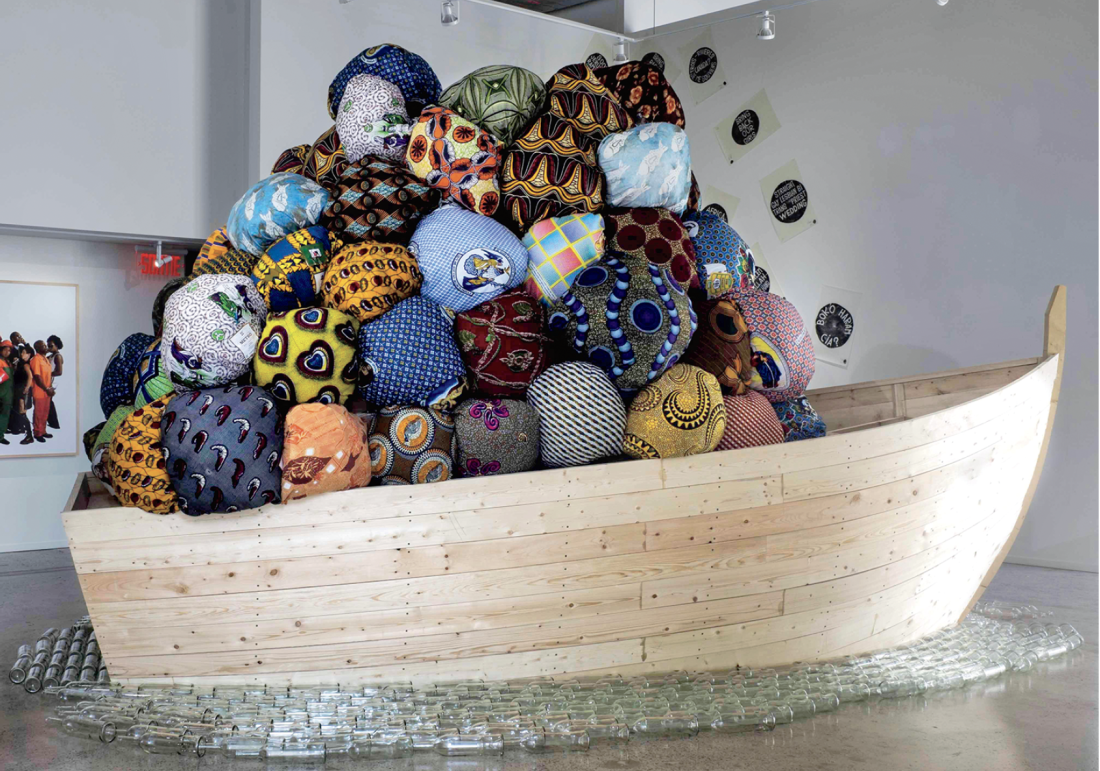Barthélémy Toguo
Barthélémy Toguo stands in an ambivalent relation to the European and North American milieu where he exhibits and makes his name but still identifies with Africa. It’s the country of Cameroon to be more specific—a region where AIDS, rape, Boko Haram and Ebola are part of the reality of daily life. Urban Requiem, Toguo’s installation in curator Okwui Enwezor’s “All the World’s Futures” exhibition at the 56th Venice Biennale, 2015, comprised carved wooden stamping objects recalling the ‘primitive’ African sculpture that has all but been eradicated from its place of origin by collectors worldwide. On the walls, texts printed from each of them proclaimed, “I am Nigeria.” “Je suis Charlie.” “End police brutality.” “Boko Haram, Ebola.” “A death in Congo.”At his Montreal show at Galerie Samuel Lallouz, Toguo presented a similar scenario of stamps/objects whose texts addressed issues of authority, fake documents, officialdom, authenticity and identity. These human-sized, hand-carved wooden stamps are collectively titled “Holy Place,” 2014, and their “proof” texts printed on paper question authority and who determines authenticity in a world that has lost its moral compass. All these issues raise questions about the state of today’s “world community” including the United Nations’s supposed role in arbitrating such disastrous scenarios. The printed text fragments on Toguo’s quasi-primitive objects, “China,” “Soon Jerusalem,” “Ramallah Hand by Hand,” “AIDS around the world condoms in Vatican,” are common currency in contemporary media. This adds a sense of hopelessness to the artist’s actions, so far from the source.

Barthélémy Toguo, The Holy Place, 2014, seven beech wood stamps, 42 x 62 cm, on seven pine wood tables, 74 x 74 cm, seven stamps print on rise paper, 46 x 63 cm.
Touching on themes of migration, dictatorship, war and identity, Toguo’s art practice addresses a world landscape where the migration and displacement seem irreversible, since the homes and places have been so disrupted they cannot be returned to. The centrepiece of the Africa show at Galerie Lallouz (which Toguo originally wanted to call “Stupid Africa”) is a boat, but not just any boat. It is a boat that carries the chattels and material goods in colourful, wrapped bundles. The chattels replace the people who should or could potentially be there carrying them—escaping war, drought, famine and at the risk of their lives. Where are the people? The actual boat is a symbol of hope of a promised future, and is surrounded by glass bottles which could symbolize communication. Instead, these containers which could be carrying a message are empty, bereft and adrift in a no-man’s-land of projection and expectation. Where are the people? It could seem a 21st-century inversion of Gauguin’s search for the exotic purity of primitivism in his painting Where Do We Come From? What Are We? Where Are We Going?, 1897–98, an artist’s embodiment of a perceived and exotic primitivist Paradise. Instead, being a homeless migrant in perpetual exodus is for millions, now a reality.
Tiny hand-built chairs representing all the 54 countries of Africa are arranged around a map of Africa made of crushed bottle glass. The crushed glass came about at the vernissage of the Africa show, when Toguo smashed glass bottles “to kingdom come” and carried the shards in Canadian Tire buckets in order to “design” a map of Africa. Barthélémy Toguo’s act confirmed the distended reality of today’s Africa, one that the world seems unable to deal with. Accounts of refugees, whose boats often sink, being turned back in Indonesia, in the Mediterranean, proliferate amid accounts of blackmail. If and when they reach ‘freedom’ they are in legal limbo for years and feature as a centrepiece to today’s media. Toguo plays with all this in his art.

Barthélémy Toguo, Road for Exile, 2015, wooden boat, 2 x 5 metres, mixed media, cloth bundles, glass bottles, various dimensions.
The “Stupid African Presidents” (2005–2008) photo series presents Barthélémy Toguo as the artist/actor playing out a variety of stereotyped roles related to Africa’s current state of being. Toguo is the dictator who stands in front of a map of Africa. Toguo sits in a white oil barrel with an empty water bottle in his mouth. Inscribed in red letters on the barrel that contains him are the words “AFRIKA OIL?” Somewhat clownish, Toguo questions the role of politics, including his own compromised position as an artist from Africa whose success in commercial galleries seems a betrayal of his perceived origins. As Toguo stated in an online interview with David Simó on this complex subject, “I do not claim being African. I do not wear straws to look African. The tiger does not need to proclaim his tigritude, it shows it! I am an artist of today’s world who is not in search of his origins. I claim a universal artistic production that an Asian can understand, that can give an emotion or bring a South American to reflect.”
But what of those of African origin in a world encased in chaos, where humanitarian issues are dealt with long after the disasters occur? And what of the financing of these disasters, a kind of ricochet effect, where profit is made from these tragedies, and far from where the disasters are taking place (with few international witnesses on hand)? One of Barthélémy Toguo’s neo-primitive stamping sculptures, and its printed text at the 56th Venice Biennale, sums it up as well as any artist could. “We are all in exile.” ❚
“Africa and Beyond” was exhibited at Galerie Samuel Lallouz, Montreal, from March 31 to June 30, 2015.
John K Grande is a Montreal-based curator, poet and arts writer.

